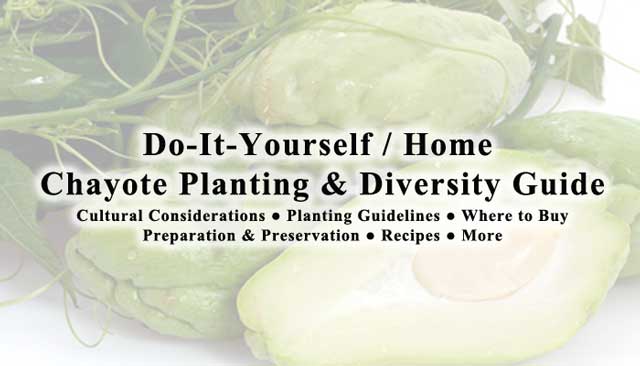
Chayote
This page is an open source resource guide for chayote. It is for growing and maintaining the most bio-diverse, delicious, and broadly applicable chayote selection possible. It contains cultural considerations, planting guidelines, descriptions, and the best places we’ve found for purchasing the species we’ve listed. As part of the One Community Highest Good food component of global transformation, this page will continue to evolve indefinitely to contain maintenance and care tips, accessioning and plant breeding and sharing information as part of the One Community open source botanical garden model, and even recipe’s, preparations, and preservation methods used on the property.
SUGGESTIONS | CONSULTING | MEMBERSHIP | OTHER OPTIONS
Click these links to be taken directly to the relevant sections on this page:
- Chayote Overview
- Cultural Considerations
- Planting Guidelines
- Specific Varieties
- Plant Material/Seed Providers
- Other Chayote Resources
- Chayote as Part of the Botanical Garden Model
- Chayote Preparation, Preservation, and Recipes
- Links to Other Edible Plant Pages
PAGES RELATED TO THIS PAGE (click icons for complete pages)
CLICK THESE ICONS TO JOIN US THROUGH SOCIAL MEDIA
CHAYOTE
Chayote (Sechium edule)
CULTURAL CONSIDERATIONS
- Chayote needs warmth and a long season
- Immature fruit will drop when temps go below 55F
- Chayote vines like moisture, mulch and regular food
- All parts of the plant are edible; leaves, fruit and tubers
- Propagation is by planting the entire fruit, vine cuttings, or tuber pieces
PLANTING GUIDELINES
Plant the fruit large end down just below the soil surface, or plant vine cuttings or tuber pieces in a warm sunny sheltered site in early spring. Protect vines from frost over the first winter. Vines begin to bear in the second year and continue for several more years. Keep vines moist and well fed with compost tea or dilute liquid seaweed.
VIDEO COMING: Planting tutorial followed by time lapse growth videos
SEE OUR HOW TO HELP AND/OR CROWDFUNDING CAMPAIGN PAGE IF YOU’D LIKE TO GET INVOLVED AND/OR SUPPORT ONE COMMUNITY’S DEVELOPMENT PROCESS.
ADDITIONAL INFORMATION
No Chayote varieties at this time. We will post them as soon as they come available.
OTHER CHAYOTE RESOURCES
We are seeking awesome chayote resources. If you know of one, please click here to share it with us so we can make this page better.
CHAYOTE AS PART OF THE BOTANICAL GARDEN MODEL
This section will evolve to include accessioning and plant breeding and sharing information as part of the One Community open source botanical garden model.
CHAYOTE PREPARATION, PRESERVATION, AND RECIPES
This section will evolve to include testimonials, recipe’s, preparations, and preservation methods used on the property first, and then later with additional information from other Highest Good collaborators and teacher/demonstration hubs.
Chayote and Avocado Salad
Recipe courtesy of: Food Network
| Total Time: 10 min Prep: 10 min Cook: Chill | Yield: 4 Servings Level: Easy |
Ingredients
| Directions
|
Chayote Soup
Recipe courtesy of: Plant Zone
| Total Time: 30 min Prep: 10 min Cook: 20 min | Yield: 4 Servings Level: Easy |
Ingredients
| Directions
Note: Generally, I’m not going to tell you how much of each to use because that’s up to you! Just look at the pictures for guidance. |
LINKS TO OTHER EDIBLE PLANT PAGES
WHO WE ARE
MAIN OPEN SOURCE HUBS
KEY FOOD COMPONENTS
- OS Hub
- Grow
- Build
- Ethical, Humane, & Conscientious Goat Stewardship
- Ethical, Humane, & Conscientious Rabbit Stewardship
- Ethical, Humane, & Conscientious Chicken Stewardship
- Food Forest
- Hoop Houses
- Apiary/Bee Yard
- Botanical Garden Creation & Inventorying
- Conscientious Wildlife Stewardship and Habitat Development
- Large-scale Gardening
- Soil Amendment & Site Preparation
 One Community
One Community





















































